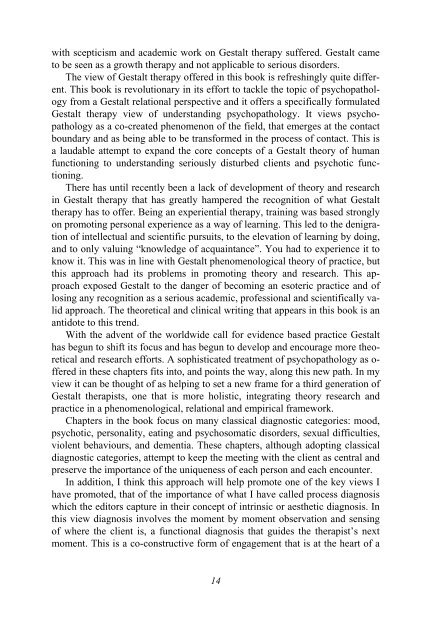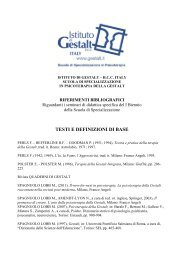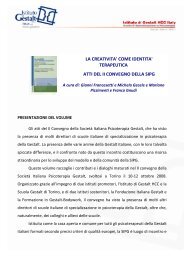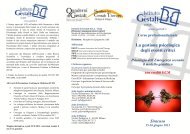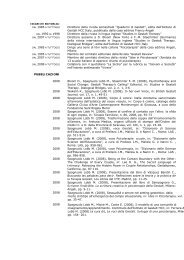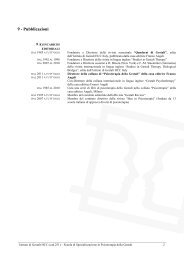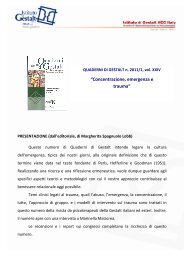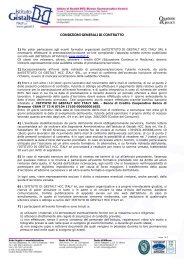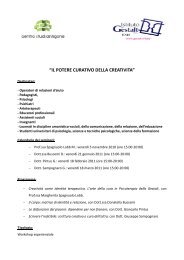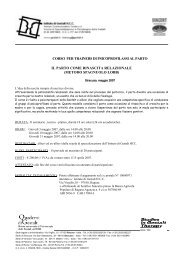E-book FrancoAngeli - Franco Angeli Editore
E-book FrancoAngeli - Franco Angeli Editore
E-book FrancoAngeli - Franco Angeli Editore
Create successful ePaper yourself
Turn your PDF publications into a flip-book with our unique Google optimized e-Paper software.
with scepticism and academic work on Gestalt therapy suffered. Gestalt cameto be seen as a growth therapy and not applicable to serious disorders.The view of Gestalt therapy offered in this <strong>book</strong> is refreshingly quite different.This <strong>book</strong> is revolutionary in its effort to tackle the topic of psychopathologyfrom a Gestalt relational perspective and it offers a specifically formulatedGestalt therapy view of understanding psychopathology. It views psychopathologyas a co-created phenomenon of the field, that emerges at the contactboundary and as being able to be transformed in the process of contact. This isa laudable attempt to expand the core concepts of a Gestalt theory of humanfunctioning to understanding seriously disturbed clients and psychotic functioning.There has until recently been a lack of development of theory and researchin Gestalt therapy that has greatly hampered the recognition of what Gestalttherapy has to offer. Being an experiential therapy, training was based stronglyon promoting personal experience as a way of learning. This led to the denigrationof intellectual and scientific pursuits, to the elevation of learning by doing,and to only valuing “knowledge of acquaintance”. You had to experience it toknow it. This was in line with Gestalt phenomenological theory of practice, butthis approach had its problems in promoting theory and research. This approachexposed Gestalt to the danger of becoming an esoteric practice and oflosing any recognition as a serious academic, professional and scientifically validapproach. The theoretical and clinical writing that appears in this <strong>book</strong> is anantidote to this trend.With the advent of the worldwide call for evidence based practice Gestalthas begun to shift its focus and has begun to develop and encourage more theoreticaland research efforts. A sophisticated treatment of psychopathology as o-ffered in these chapters fits into, and points the way, along this new path. In myview it can be thought of as helping to set a new frame for a third generation ofGestalt therapists, one that is more holistic, integrating theory research andpractice in a phenomenological, relational and empirical framework.Chapters in the <strong>book</strong> focus on many classical diagnostic categories: mood,psychotic, personality, eating and psychosomatic disorders, sexual difficulties,violent behaviours, and dementia. These chapters, although adopting classicaldiagnostic categories, attempt to keep the meeting with the client as central andpreserve the importance of the uniqueness of each person and each encounter.In addition, I think this approach will help promote one of the key views Ihave promoted, that of the importance of what I have called process diagnosiswhich the editors capture in their concept of intrinsic or aesthetic diagnosis. Inthis view diagnosis involves the moment by moment observation and sensingof where the client is, a functional diagnosis that guides the therapist’s nextmoment. This is a co-constructive form of engagement that is at the heart of a14


